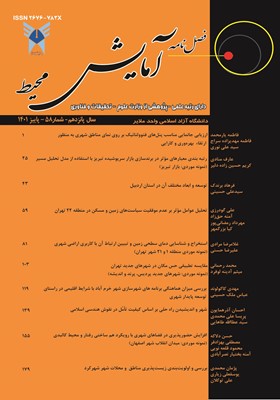بررسی میزان هماهنگی برنامههای شهرسازی شهر خرمآباد با شرایط اقلیمی در راستای توسعه پایدار شهری
محورهای موضوعی : آمایش محیط
مهدی کاکولوند
1
,
عباس ملک حسینی
2
![]()
1 - (دانشجوی دکتری جغرافیا و برنامه ریزی شهری، واحد ملایر، دانشگاه آزاد اسلامی، ملایر، ایران)
2 - (دانشیار گروه جغرافیا و برنامه ریزی شهری، واحد ملایر، دانشگاه آزاد اسلامی، ملایر، ایران)
کلید واژه: اقلیم, توسعه پایدار شهری, خرم آباد, برنامههای شهرسازی,
چکیده مقاله :
در دههی آخر قرن 21 مفهوم توسعه پایدارشهری به عنوان یکی از موضوعهای روز دنیا مطرح میشود. ایران سرزمینی با چهار اقلیم متفاوت است که در هر اقلیم با توجه به شرایط و ویژگیهای اقلیمی، پدیدههای زیستمحیطی و انسان ساخت مطابق با آن شرایط اقلیمی مشاهده میشود. تحقیق حاضر بررسی میزان هماهنگی برنامههای شهرسازی شهر خرمآباد را با توجه به شرایط اقلیمی در راستای توسعه پایدار شهری مورد بررسی قرار داده است. در این پژوهش از روش تحقیق توصیفی از نوع پیمایشی استفاده شده است. برای اندازهگیری متغیرهای این تحقیق از پرسشنامه استفاده میشود و همچنین روشهای آماری مورد استفاده در این پژوهش آزمون همبستگی اسپیرمن و آزمون تی استودنت و آزمون کولموگرف – اسمیرنوف میباشد. یافتههای پژوهش نشان میدهد که در شهر خرمآباد هماهنگ سازی اقلیمی در مقیاس منطقهای برای کاهش مصرف بهینه انرژی در جهت رسیدن به توسعه پایدار انجام نشده است.
One of the most important challenges in contemporary cities is the identity crisis that is affected by the lack of sense of place, belonging to the place, and attachment to it. In this regard, new towns have been exposed to a lack of identity more than others due to less residential background. On the other hand, understanding and analyzing the effective factors of the sense of place in new towns have significant effects on solving the existing issues. For this reason, it is a must to study the current situation of new towns. So, this study aims to compare the sense of place among three new towns around Tehran, namely Pardis (phase 1), Parand (phase 2), and Andisheh (phase 3). The method of this qualitative study is descriptive-analytical based on documental studies and surveys. In this study, reviewing the literature shows that sense of place is a subjective concept that is derived from objective aspects. This sense depends on both individuals who percept it and the characteristics and situation of the place. The data (based on respondents who were residents of case studies by sampling) were analyzed using the TOPSIS technique. The results show that the sense of place in phase 3 in Andisheh new town is more than that in the two others that is because of the higher quality of the physical and spatial environment and also adaptation to standards and principles of urbanism. So, improving the physical and spatial qualities in new towns in particular in the field of various activities (mix land use) that are responding to the daily needs of residents, high quality of infrastructures such as roads, facilities, and equipment, considering to order, harmony and human scale of the space during planning and designing, making the spaces attractive for increasing the presence and high-quality urban furniture can increase a sense of place that leads to identity in these areas.
Morillon، D.، Saldana. R. Tejeda-MartinezA Human bio climatic atlas for Mexico. Solar Energy; 76:781-792، 2004
_||_


